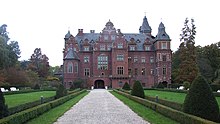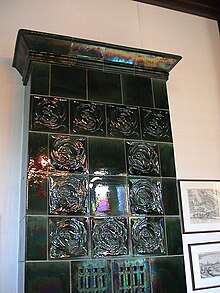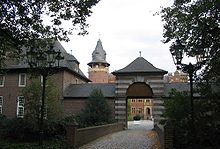Krickenbeck Castle
The Krickenbeck Castle is located in Nettetal in the Lower Rhine , in the field of Krickenbecker lakes . The moated castle , which was exposed to decay for a long time , was used as the WestLB conference venue between May 1991 and August 2011 .
Old castle
Before the castle and its direct predecessor castle was built at its current location, about two kilometers south of the Nette was the Krickenbeck Castle , also known as alde Borch or Alt-Krickenbeck . The first documented owner of this castle was Heinrich Graf von Krickenbeck, son of Count Gerhard II von Wassenberg in 1104 . The next verifiable count of Krickenbeck Castle was Reginar von Krickenbeck (1149–1167). His daughter Alveradis von Krickenbeck-Millendonk married Count Friedrich von Berg-Altena . Their son, Adolf I. Graf von der Mark , Altena and Krickenbeck, sold the “Bona de Crikenbeke” in 1243 to his brother-in-law Otto von Geldern . On March 3, 1243, Count Otto von Geldern acquired it from Count Adolf von der Mark. At this point in time, the old castle seems to have already been destroyed or at least become uninhabitable, as it is no longer mentioned.
It is unclear why the old castle, which Count Reginar was definitely still inhabited, was abandoned or destroyed. One possible cause could have been the military conflicts in the context of the Isenberg turmoil that has been going on since 1232 . Between 1232 and 1243 Adolf I fought against the heirs of his relative Friedrich von Isenberg , who was executed in 1226 as the main conspirator against both relatives, the Archbishop of Cologne, Engelbert von Berg .
new Castle
In the middle of the 13th century, the castle was relocated to the Niers lowland in Hinsbeck . Neu-Krickenbeck was probably built between 1244 and 1251 as the "Bona de Crikenbeke" without the old castle becoming Geldrisch. At the end of the 14th century, the new castle and its associated area belonged to the county of Kleve . In 1391 Count Adolf I of Kleve and his wife Margaretha bequeathed their rights to the Kriekenbeck family to their son Adolf II of Kleve .
The four Krickenbeck lakes , named after the castle in their midst, were created by peat bogs at the beginning of the 15th century. When the Kempen bailiff Arnold von Wachtendonk married Anna Salome von Holthausen on November 21, 1604 , Krickenbeck Castle is mentioned in the marriage contract. The Wachtendonk / Holthausen alliance coat of arms can be seen on the north-east wall of the castle.
The palace experienced its heyday from 1623 under Baron Johann Friedrich von Schaesberg , governor at the Düsseldorf court Jan Wellems, the Elector Johann Wilhelm . When Johann Friedrich von Schaesberg (* December 21, 1598, † February 17, 1671) married Ferdinanda von Wachtendonk, who was not yet 15 years old, on February 19, 1623, the castle came into the possession of the von Schaesberg family through marriage. Baron Wolfgang Wilhelm von Schaesberg converted the castle into a palace - a Lower Rhine moated castle serving as a manor . His son Johann Friedrich von Schaesberg (* 1663/64 in the moated castle Krickenbeck) studied in 1681 at the University of Cologne . In 1684, Krickenbeck was captured and looted by French troops, and various occupations during the Thirty Years' War required the outer bailey to be completely rebuilt in 1695.
Between 1708 and 1721 Johann Friedrich II. Von Schaesberg had the castle converted into a baroque mansion by the Venetian master builder Simon del Sarto . From 1856 to 1860, Count Rudolf von Schaesberg (1816–1881) and his wife Mathilde (1824–1891), née Countess von Waldburg-Zeil -Trauchburg, commissioned a further conversion into a neo-Gothic castle based on plans by the Cologne diocesan master builder Vincenz Statz . He converted the moated castle into a Gothic representative building, which was supposed to bring the past of the house to mind. The sea side received a new east tower, and a south-east bay was built.
On September 7, 1902, a fire destroyed the entire manor house. The owner Heinrich Graf von Schaesberg-Tannheim found out that “Krickenbeck Castle was on fire” from his distant place of residence in the Allgäu through a telegram from his chief pensioner Wirtz. The building was destroyed by the carelessness of a house painter who “secretly smoked an earthen pipe” high under the roof during the lunch break. Count Wilhelm Heinrich (1855–1910) commissioned the Hanoverian architect Hermann Schaedtler with the new building . From 1903 to 1904 a three-wing castle in the neo-renaissance style was built .
In 1943 the von Schaesberg family moved to their Tannheim Castle in Württemberg and took the castle's furnishings with them. In June 1943 a children's home from Mönchengladbach and the Dernbach sisters moved into the castle. In October 1944 they were moved to Olpe .
In March 1945 the staff of the "363rd Tactical Reconnaissance Group" of the USAAF moved into the uninhabited castle and used it as headquarters. In 1947 the Sisters of St. Catherine moved to the Congregation of the Sisters of St. Virgin and Martyr Catherine, into the castle; this order was expelled from East Prussia in 1945. It then served as a retirement home for what was then the Kempen-Krefeld district until 1969 .
From July 1969 the castle stood empty unused. In 1970 the Langenfeld house in Wachtendonk-Wankum , which had previously been part of the property, was also sold. Haus Bey, on the other hand, still belongs to Schaesberg's property.
In the 1970s the structure fell into disrepair. In 1977, parts of the castle were used as a backdrop for the television film Die Vorstadtkrokodile . A state subsidy for roof repairs planned for 1981 was not approved by the Düsseldorf district government because the monument was not used.
New lock
Attempts to use it as a hunting museum or with luxury apartments have failed. The vacant castle was exposed to further decay, which was accelerated by the progressive destruction of the roof covering.
In the autumn of 1986, WestLB decided to set up its training and further education academy in the castle with events on topics related to in-company training. After extensive refurbishment, renovation and expansion work, the castle, which had been redesigned from the foundation walls in early 1989, was given its new purpose in May 1991 in the presence of NRW Prime Minister Johannes Rau . The mansion and the outer bailey were renovated, a new hotel wing (160 single rooms) and a leisure center with gym and swimming pool were built on the site of a former farm with construction costs (gross) of around DM 85 million. The manor house and the outer bailey were oriented the WestLB in the noble times around 1850 and provided appropriate stucco and chimney renovation; the knight's hall and the library received original items from that time.
The renovation work was carried out in close cooperation with the state curator in North Rhine-Westphalia, which also included the reconstruction and restoration of the palace gardens. This was accompanied by a large-scale ecological program for the renaturation , preservation and promotion of this architectural and ground monument . After WestLB had to be liquidated by a resolution of the EU Competition Commission from December 20, 2011 to December 31, 2016, the bank no longer had any use for the lock. In 2015 she sold Schloss Krickenbeck to the French Châteauform Group, which markets it as a seminar house.
literature
- Paul Clemen (ed.): The art monuments of the district of Geldern (= The art monuments of the Rhine province . Volume 1, section 2). L. Schwann, Düsseldorf 1891, pp. 51-54 ( online ).
- Ludger Fischer : The most beautiful palaces and castles on the Lower Rhine . Gudensberg-Gleichen 2004, ISBN 3-8313-1326-1 .
- Rolf Gilbert: Krickenbeck Castle 1987–1992. Five years of a history spanning many centuries . In: Heimatbuch des Kreis Viersen , 43rd episode, 1992, pp. 131–140.
- Harald Herzog: Krickenbeck - the castle as an ornament . In: Rheinische Heimat . No. 33, 1996, pp. 161-173.
- Harald Herzog: Rhenish castle buildings in the 19th century . Bonn 1981, ISBN 3-7927-0585-0 , pp. 27, 51.
- Helmut Klein, Herbert Hubatsch, Klaus van de Weyer: Krickenbeck Castle. Landscape and nature . WestLB Akad. Krickenbeck Castle [et al.], Nettetal 1992.
- Leo Peters : The Krickenbeck castle building from 1903 . In: Heimatbuch des Kreis Viersen , 27th episode, 1976, pp. 229–232.
- Leo Peters: On the building history of Krickenbeck Castle in the early 18th century . In: Rheinische Heimat . No. 11, 1974, pp. 130-133.
- Stefan Frankewitz : The office of Krickenbeck and the city of Venlo in the late Middle Ages . In: Heimatbuch des Kreis Viersen , 45th episode, 1994, pp. 39–51.
- Marinus Flokstra u. Kurt Niederau : The von Holthausen on Krickenbeck, 1430–1623 . In: Heimatbuch des Kreis Viersen , 45th episode, 1994, pp. 52–68.
- Gert Kaiser: Krickenbeck. Biography of a castle on the Lower Rhine WestLB Verlag, Düsseldorf 1991.
Web links
- Official website of Schloss Krickenbeck GmbH
- Photo album and information about Krickenbeck Castle
- Krickenbeck Castle to the Alexander Duncker Collection (PDF; 220 kB)
Individual evidence
- ↑ Ralf G. Jahn, in: Genealogie der Vögte, Counts and Dukes of Geldern , 2001, editors Johannes Stinner and Karl-Heinz Tekath, p. 32.
- ↑ Ludwig Röhrscheid, Rheinische Vierteljahresblätter , Volume 53, 1989. P. 25
- ^ Karl Bosl, Handbook of Historic Sites in Germany , Volume 3, 1970, p. 434
- ^ Theodor Joseph Lacomblet, in: Document book for the history of the Lower Rhine or the Archbishopric of Cöln, certificate 952 . 1853, part 3, 1301-1400, p. [850] 838. Online version
- ↑ Heinz Finger / Elisabeth Niggemann, Books for Science , 1994, p. 129
- ↑ Cordula Steffens-Hammes, The palace buildings of the architect Hermann Schaedtler 188-1927 , 1996, p. 292
- ↑ At that time the Wehrmacht was preparing to hold the front on the Maas. Krickenbeck Castle is seven kilometers from the center of Venlo . In the course of these preparations, the castle was cleared.
- ↑ 33rd PRS online, History
- ↑ Decision of the EU Commission on state aid C 40/2009 and C 43/2008 of December 20, 2011, Rn 45 (PDF; 185 kB)
- ↑ http://www.rp-online.de/nrw/staedte/nettetal/chateauform-gruppe-kauf-krickenbeck-aid-1.4750274
Coordinates: 51 ° 21 '3.3 " N , 6 ° 15' 24.2" E





